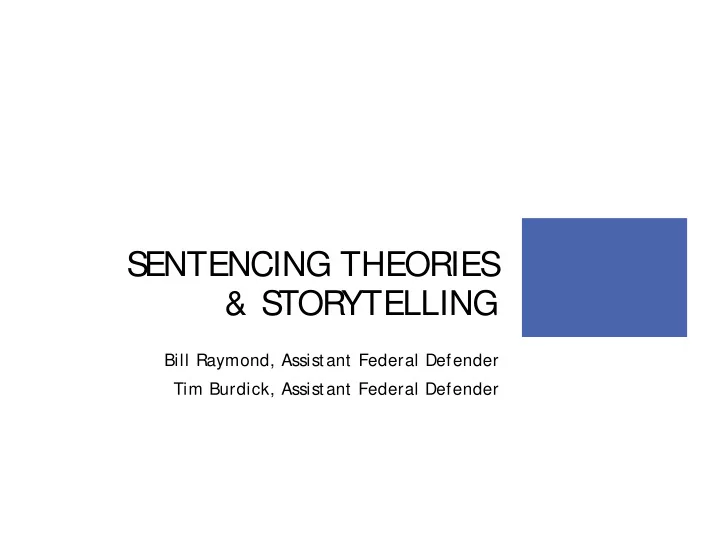

S ENTENCING THEORIES & S TOR YTELLING Bill Raymond, Assistant Federal Defender Tim Burdick, Assistant Federal Defender
hould Not Be entencing S What S
DO YOUR HOMEWORK • Know the law • Options Available • Cases that S upport Y our Argument • 18 U.S .C. 3553(e) • Know the S tatistics • Recidivism S tatistics • S entencing S tatistics • Know Y our Case • Client Hstory • S upporting Information/ Records • Presentence Report • Expert Analysis
our Client’s Goals Know Y
S ENTENCING THEOR Y • S ummarizes the factual, emotional and legal reasons why the court should impose the sentence you want • Tells your client’s story of mitigation, rehabilitation, or reduced culpability, and it resolves problems and questions the j udge may have about imposing the sentence you want
F ACTUAL • Facts Important We Introduce • Lack of criminal record • History of non-violence • Takes care of family • Other good deeds • Facts We Must Neutralize • Had a Gun at the Ready • Fired four times • Prior acts of violence • Takes Into Account All Facts of Client’s Life
EMOTIONAL • Tells a moving story that explains why your client should get the sentence you are requesting. • It makes the Judge want to give the result you are asking for
LEGAL • Guidelines • Interpretation • Deconstruction • S tatistical analysis • S tatutes • Caselaw
RES OL VES PROBLEMS & QUES TIONS FOR JUDGE • If I let him out, will he do it again • If I send her to j ail, how long should I keep her there • How can I j ustify my sentence to the public
TELLS A S TOR Y • No different than trial practice • The most persuasive way to convey your message is through a story • The memorable way to convey your message is through a story • The most interesting way to convey your message is through a story • These principles can apply to j udges & prosecutors the same way they apply to j urors
S TOR YTELLING AT S ENTENCING • Know Y our Audience • Know The Elements of a Persuasive S tory • Know Y our Tools –Telling Y our Client’s S tory
KNOW YOUR AUDIENCE • Prosecutor • Judge
ECUTOR JUDGE ALL IN ONE PROS
PROS ECUTOR • Mandatory Minimums • Personality/ Persuasive • Ask them what they want to know/ hear • Let them talk to people directly • Judge
JUDGE • Personality • Persuasive • Guidelines & S tatistics • 18 U.S .C. 3553(a) • S traight Mitigation
ELEMENTS OF A PERS UAS IVE S TOR Y • S olid S tory • Compelling Characters • Integrated Presentation of all of the Mitigating Evidence • Emotionally Evocative Images
S OLID S TOR Y • S olid S tory is Unique • S olid S tory is S treamlined • S olid S tory is Moving • S olid S tory incorporates S mall S tories to tell a Big S tory
COMPELLING CHARACTERS • Main Character – Client • Get insight into who the client is • Get insight into how the client interacts with others • S upporting Characters – People Who Know Him/ Her • Incorporate best testimony from large groups of people • Incorporate best testimony in a short time
INTEGRATED PRES ENTATION • Incorporate all of your Mitigating Evidence • Client’s S tatement • Witnesses S tatements • Records • Experts • Photos • Not limited by the Federal Rules of Evidence
EMOTIONALL Y EVOCATIVE IMAGES • Figuratively • S pecific, detailed stories from witnesses • Literally • Photos • Videos
TELLING YOUR CLIENT’ S S TOR Y (KNOW YOUR TOOLS ) • Live Witnesses • Photos • Video • S entencing Memorandum • Letters/ Reports/ S tatements
LIVE WITNES S ES - EVALUATION • Evaluate Information Witness Provides • Better for Live Testimony v. S tatement v. Letter • S pecial Concerns with Client • Post Trial • Better for Live Testimony v. S tatement v. Letter • Expert Witnesses • Type (Mental Health/ S ub Abuse/ S ex Offense/ Other) • Better for Live Testimony v. Report v. Letter • Provide with Information/ Ammunition Necessary
LIVE WITNES S ES - PREP ARATION • Always Do It • Avoid Narratives – Do Questions and Answers • Craft the testimony to further your theory
PHOTOS • Pictures Give Life to Y our Words • Provide Candid S napshots of Who Y our Client is Outside of the Courtroom • Able to S how Y our Client Over Long Periods of Time • More Persuasive because not produced solely for the purpose of sentencing
VIDEOS • Primacy • Editing of Lay Witnesses • Integrated Presentation • Break up Individual Witnesses
S ENTENCING MEMORANDUM • Primacy • The Law • S tatistics • Prime the Court for S entencing Hearing
/ REPORTS LETTERS • No Cross • Primacy
Recommend
More recommend